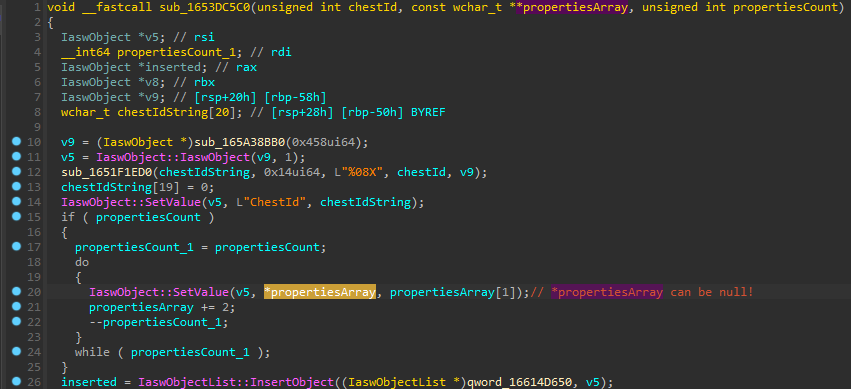Avast Anti-Virus privileged arbitrary file create on virus quarantine (CVE-2023-1585 and CVE-2023-1587)
0x00: Introduction
I’m not a big fan of privileged file operation abuse, because such vulnerabilities are usually quite trivial. But there are attack surfaces where you really want to find a vulnerability - because it seems difficult due to the great attention of developers and researchers to it, the old age of the feature and presumable comprehensive testing, as well as its prevalence throughout the entire line of Products - that, due to the nature of the researched feature, it is necessary to search for vulnerabilities of exactly this class. An example of such attack surface is undoubtedly the functionality of removing malware in Anti-Viruses - the main and most important feature of any Anti-Virus, in fact its “showcase”. And I decided to look for similar vulnerabilities in the malware removal engine (also known as “quarantine”) of Avast Free Antivirus. Avast is a fairly widespread Product so that a vulnerability in it affects a large number of machines, it is developed quite responsibly in terms of security, and besides, similar vulnerabilities have already been fixed in it not so long ago (rack911labs research and SafeBreach research). My end goal was to execute code in the SYSTEM context as a result of abuse the malicious file removal mechanism. So the research didn’t seem like a cakewalk at first – that would be more interesting! Below is the report “as-is” I sent to the Avast development team to fix the vulnerabilities found.
0x01: High-level overview of the vulnerability and the possible effect of using it
Avast Anti-Virus since ver. 22.3.6008 (I didn’t check previous versions, but it is very likely that they are also vulnerable), when a file virus is detected, deletes the file in the context of the SYSTEM account. To mitigate file redirection attacks, it checks the entire path for any types of links, converts the path to path without links, and only then deletes the file. However, path checking and file removing is not atomic operation, so this algorithm has TOCTOU vulnerability: by manipulating with path links attacker can redirect service’s operations and delete arbitrary file/directory. This vulnerability has been assigned CVE-2023-1585.
Although deleting an arbitrary file/directory is not in itself a critical vulnerability, this bug can be upgraded to code execution as
SYSTEM. For this attacker needs to use the bug to delete the contents of directory "C:\ProgramData\Avast Software\Avast\fw" and then
delete directory itself. And thereafter restart the main process (AvastSvc.exe) via reboot or crash as implemented in PoC. On starting,
if aforementioned directory does not exist, service recreates it with permissive DACL – full access for Everyone. At the end attacker
just need to call RPC-method that will execute privileged
CopyFile() in fully attacker-controlled directory.
Such privileged CopyFile() gadget obviously leads to arbitrary file write and respectively code execution as SYSTEM. Service crash
issue has been assigned CVE-2023-1587, other problems have been classified
as weird behavior.
0x02: Root Cause Analysis
On file virus (2) detecting Avast Anti-Virus (AV) removes the file in the context of the SYSTEM account. This is quite dangerous since by
manipulating links in a controlled path attacker can provoke a situation where anti-virus service deletes the wrong file. Avast’s
developers are aware of this risk and therefore AV service tries to create file with random name in same directory. It mitigates junction
creation because junction can be created only in empty directory (symbolic links need admin rights, hardlinks are not dangerous for file
delete operations - thus they are out-of-scope attacker’s tools). But if attempt to create file with random name failed (4) AV service
continues to realize own algorithm. So this mitigation is optional because attacker can simply set deny FILE_ADD_FILE ACE for SYSTEM on
the parent directory (1).

Then AV main service checks the entire path to virus for any types of links (5), converts the path to path without links, and only next
deletes the file. AV service makes these actions to mitigate file redirection attacks. But without successfully created file with random
name parent directory of virus is not locked from creating junction in its place.

Between previously described path checks and subsequent description of file deletion exists time window, when attacker can redirect path to
another destination. This time window is quite short, but attacker can extend it. After path checking and before file deletion AvastSvc
writes logs (6) to logfile named "C:\ProgramData\Avast Software\Avast\log\Cleaner.log". Therefore, if attacker sets RWH-oplock (3) on
Cleaner.log, it blocks execution of deleting virus algorithm and attacker can reliably redirect (7) parent directory of virus to
previously inaccessible location. Good news is that at time when the oplock triggers, handles of files inside the directory are not open.

After directory switching main AV service following symbolic links deletes arbitrary file/directory (8) that attacker wants. Moreover
thanks to service’s privileges and CreateFile() flags attacker can remove even
WRP-protected files: TrustedInstaller owned files
accessible with READ-only rights for SYSTEM.

Putting all the steps together, for successful exploitation arbitrary file/directory delete (CVE-2023-1585) we need to do the following:
- Create directory
".\Switch"with restrictive DACL (denyFILE_ADD_FILEACE for SYSTEM) and test EICAR virus".\Switch\{GUID}.dll"; - Create oplock on
"C:\ProgramData\Avast Software\Avast\log\Cleaner.log"and wait for test virus will be quarantined; - When oplock triggers, remove test virus
".\Switch\{GUID}.dll"and switch parent directory with mount point to native symbolic link, e.g. mount point".\Switch" -> "\RPC Control"and native symbolic link"\RPC Control\{GUID}.dll" -> "??\C:\Windows\System32\aadjcsp.dll"; - Release the oplock, wait couple of seconds, then make sure
"C:\Windows\System32\aadjcsp.dll"was deleted.
Arbitrary file/directory delete is not high-impact vulnerability, usually it leads only to DoS. However, there exist approaches to upgrade this low-impact bug to code execution as SYSTEM - here and here. The former is already fixed on modern operating systems, while the latter is not reliable due to exploited race condition. So it was decided to find own yet unpatched 100%-reliable way to improve impact of this bug.
Code path that can help upgrade file/directory delete to code execution was found in Avast’s codebase. On starting if
"C:\ProgramData\Avast Software\Avast\fw" directory does not exist, service AvastSvc.exe creates it with permissive DACL – full access
for Everyone.
Waiting for a computer or service restart can take a long time, so null dereference bug (CVE-2023-1587) was found in RPC-interface named
"aswChest" with UUID "c6c94c23-538f-4ac5-b34a-00e76ae7c67a". When attacker calls Proc3 to add file to the chest, he must specify an
array of key-value pairs (so-called file properties), and if property name (*propertiesArray on the image) is null, service immediately crashes.

As it was already said after restart Avast main service creates "C:\ProgramData\Avast Software\Avast\fw" directory, if it does not exist,
with very permissive DACL – full access for Everyone. And for the attacker, it remains to find a code that manipulates the files in this
directory in such a way that it will allow you to get an arbitrary file write primitive. It can be various variants of a suitable code patterns,
but it was found code path that implements *.ini files reset inside directory. This code is reachable from RPC-interface named "[Aavm]"
with UUID eb915940-6276-11d2-b8e7-006097c59f07. When attacker calls method with index 58, service copies, for example, file "config.ori"
to "config.xml" inside directory "C:\ProgramData\Avast Software\Avast\fw". Such gadget is sufficient to obtain a primitive “arbitrary file write”.
Last and also probably least – Avast AV prevents access to own RPC-interfaces for untrusted processes. This is implemented as part of a
self-defense protection mechanism. On allocating RPC-context for further communication with interface RPC-server checks client is trusted
and only in this case creates valid handle for the client. To bypass this restriction was implemented self-defense bypass based on
SetDllDirectory() for child AvastUI.exe
process configuring and subsequent inject via dll-planting. I don’t want to go into the details of this topic here, but you can check it out
in the source code of the PoC.
By chaining both vulnerabilities (CVE-2023-1585 and CVE-2023-1587) into a chain, attacker could obtain arbitrary file write primitive:
- Using CVE-2023-1585 delete target file, the contents of directory
"C:\ProgramData\Avast Software\Avast\fw"and then delete directory itself; - Bypass self-defense and call
Proc3of RPC-interface"aswChest” to crash and restart main service (CVE-2023-1587); - Make sure directory
"C:\ProgramData\Avast Software\Avast\fw"is now Everyone full accessible; - Create mount point to native symbolic link, e.g. mount point
"C:\ProgramData\Avast Software\Avast\fw" -> "\RPC Control"and native symbolic links"\RPC Control\config.ori" -> "??\C:\Users\User\Desktop\PoC\pwn.txt","\RPC Control\config.xml" -> "??\C:\Windows\System32\aadjcsp.dll" - Call
Proc58of RPC-interface"[aswAavm]"to trigger execution privilegedCopyFile()in"C:\ProgramData\Avast Software\Avast\fw"directory; - Make sure
"C:\Windows\System32\aadjcsp.dll"was successfully replaced.
0x03: Proof-of-Concept
The full source code of the PoC can be found on my github.
Steps to reproduce:
- Copy
AswQuarantineFileExploit.dllto target virtual machine where Avast Free Anti-Virus is already installed; - Run
powershell.exeand callrundll32.exewith DLLAswQuarantineFileExploit.dll, exported functionExploitand two arguments: 1st – the name of a file that replaces the file specified by 2nd argument, 2nd - the name of the file being replaced. Example ofrundll32command line:rundll32 .\AswQuarantineFileExploit.dll,Exploit C:\Users\User\Desktop\PoC\pwn.txt C:\Windows\System32\aadjcsp.dll - Make sure file passed as 2nd argument was successfully replaced with file passed as 1st argument.
Note: The exploit can as well create file if it does not exist and overwrite files owned by TrustedInstaller and accessible only for READ for SYSTEM account.
And below is demo of the PoC:
Note: It’s worth noting that PoC code is adapted for Avast Free Antivirus 22.5.6015 (build 22.5.7263.728). This is important, because the exploit intensively uses RPC interfaces, and the layout of the RPC interface may change slightly between Product versions.
Getting code execution as SYSTEM from arbitrary file write primitive is quite trivial (e.g. you can use that trick), so this step is not implemented in the PoC and is not covered in this report.
0x04: Disclosure Timeline
-
25-06-2022 Initial report sent to Avast.
-
03-10-2022 Initial response from Avast stating they got displaced my report and are now being reviewed it.
-
19-10-2022 Avast triaged the issue reported as a valid issue and redirected me to the NortonLifeLock bug bounty portal.
-
27-10-2022 Norton triaged the issue reported as a valid issue and is starting work on a fix.
-
15-12-2022 Norton released patched version of product and is requesting retest of the implemented fix.
-
09-02-2023 I reported to Norton that fixes were incomplete and should be reworked.
-
02-03-2023 I retested new fixes and approved they were correct.
-
19-04-2023 Norton registered CVEs and published advisories.
-
26-04-2023 This post has been published.
